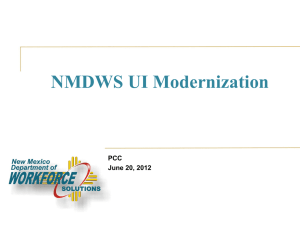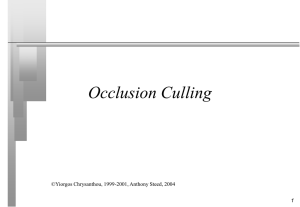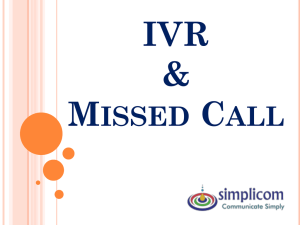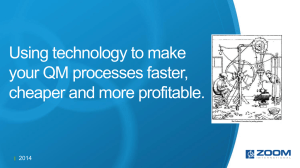Visibility culling
advertisement
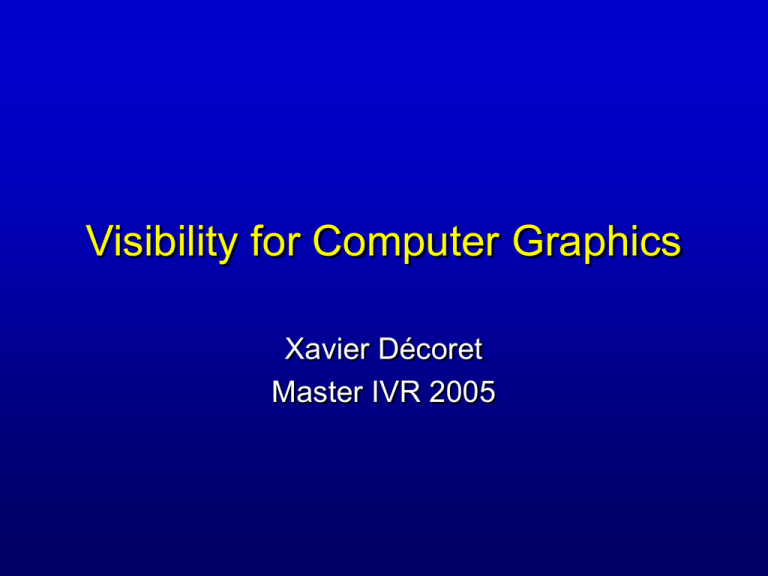
Visibility for Computer Graphics Xavier Décoret Master IVR 2005 Foreword Visibility in other domains Robotics path planning Vision Visibility in CG Real-time rendering Lighting computations focus of this talk Master IVR 1 What you will learn Stakes & issues Definitions & terminology Algorithms Toolkit Master IVR 2 Context (1/3) Models are costly to display Geometric complexity intersections in ray-tracing projection & rasterization in OpenGL/DX9 transmission (CPU GPU,server client) Appearance complexity We must treat only what’s necessary Is it visible? How much is it visible? LOD selection “Ce que l’on ne voit pas, on peut l’ignorer.” Graham Greene Master IVR 3 Context (2/3) Realism requires light simulation Shadow casting hard & soft shadows Light transport radiosity We must find amounts of light received Do I “see” a light source? How much do I “see” it? Umbra intensity Form factors “Le soleil ne sait rien de l'ombre.” Eugène Guillevic Master IVR 4 Context (3/3) Two domains of application Occlusion Culling more about “is it visible?” Lighting Computations Hardly Visible Sets [Andujar00] CC Shadow Volumes [Loyd03] more about “how much is visible?” Common problematic “What is seen from here in that direction?” Dual but equivalent terminology Master IVR 5 Context (3/3) Two domains of application focus of this talk Occlusion Culling more about “is it visible?” Lighting Computations Hardly Visible Sets [Andujar00] CC Shadow Volumes [Loyd04] more about “how much is visible?” Common problematic “What is seen from here in that direction?” Dual but equivalent terminology Master IVR 6 Occlusion culling (1/4) Definition Quickly reject what is not visible Goal Reduce unecessary processing Ex: “How do you draw a white wall?” • draw the terrain behind • draw a castle on the terrain • draw trees around the castle and cattle in the field • draw the white wall ! Master IVR 7 Hidden Face Removal Definition For each ray/pixel, find visible surface Goal Guarantee image is “correct” Hidden Face Removal vs. Occlusion Culling Imaging process Occlusion Culling Hidden Face Removal step 1 • project Reduce unecessary 3D model overdraw• rasterize • z-buffer ex: OpenGL Image Master IVR 8 Occlusion culling (2/4) Definition Quickly reject what is not visible Goal Reduce unecessary processing Meaning of “visible”? early cheaply no ray from eye to element do not contribute to final image The problem of granularity Cost vs. benefit OpenGL optimizations Bounding volumes Hierarchical culling Master IVR 9 Occlusion culling (3/4) Definition Quickly reject what is not visible Goal Reduce unecessary processing Example Hierarchical Frustum Culling bouding volume hierarchy scene elements Master IVR 10 Occlusion culling (3/4) Definition Quickly reject what is not visible Goal Reduce unecessary processing Example Hierarchical Frustum Culling A bouding volume hierarchy B A B C D Optimized [Assarson00] dPVS [Aila02] C D Master IVR 11 Occlusion culling (4/4) Terminology Viewpoint/viewcell a point/region from where we compute visibility Visible Set the set of elements exactly visible from a viewpoint/viewcell Potentially Visible Set the set an algorithm thinks is visible from a viewpoint/viewcell Classification Conservative VS PVS Aggressive VS PVS eVSPVS e is hardly visible Master IVR 12 From point vs. From region Two approaches for culling Compute PVS online for current viewpoint Compute PVS offline for finite # of viewcells partition the navigable space in viewcells pre-compute PVS offline for every viewcells approximate PVS(viewpoint) by PVS(viewcell viewpoint) From region visibility also useful for database pre-fetching viewcell placement Analogy with area vs. point light sources Master IVR 13 The Erosion Theorem From point → from region Reduce occluders and occludees Different of “Extended Projections” [Durand00] erode occluders, enlarge occludees use projections on plane [Wonka00] [Decoret03] Master IVR 14 What causes occlusion An occludee is hidden by several occluders Occluder fusion is important Occluder fusion is difficult to account for from point : fused umbra Master IVR 15 What causes occlusion An occludee is hidden by several occluders Occluder fusion is important Occluder fusion is difficult to account for from point : fused umbra from region : fused umbra and penumbra Master IVR 16 Occlusion in ray-space (1/2) Set of rays S from viewpoint/cell to occludee Each occluder blocks a set of rays Bi Hidden iff the union of Bi is dense in S we ignore “single” unblocked rays computations in dual space [Bittner01] Master IVR 17 Occlusion in ray-space (2/2) Feasible in 2½D [Bittner01] Harder in 3D Ray-space is 4D embedded in 5D (Plücker) Feasible exactly [Nirenstein00] but slow Conservative factorization [Leyvand03] Robustness issues Epsilon visibility [Duguet02] Master IVR 18 Ray-space factorization [Leyvand03] •from region •separate horizontal/vertical •horizontal: exact •vertical: conservative •hardware accelerated •very fast Master IVR 19 Various algorithms Is it conservative? What kind of occlusion can it detect? What kind of scene can it handle? Is it offline or online? What is the complexity? Theoretical complexity (cpu/memory) Implementation complexity Does it work with moving objects? Master IVR 20 Cell and portals Architectural environments Cells connected by portals Cells are visible through sequence of portals pre-process [Teller91] Master IVR 21 Cell and portals Architectural environments Cells connected by portals Cells are visible through sequence of portals pre-process [Teller91] dynamic [Luebke95] [Luebke95] Master IVR 22 Cell and portals Architectural environments Cells connected by portals Cells are visible through sequence of portals pre-process [Teller91] dynamic [Luebke95] Finding cells and portals Floodfill [Haumont03] robustness to input Master IVR 23 Cell and portals Architectural environments Cells connected by portals Cells are visible through sequence of portals pre-process [Teller91] dynamic [Luebke95] Finding cells and portals Floodfill [Haumont03] robustness to input Two pass [Lerner03] initial partition optimization of cells/portals Master IVR 24 Voxelisation Voxelize scene rasterize polygons in an octree find interior/exterior by floodfill Visibility of pairs of cells Occlude by opaque voxels interior voxels previously occluded voxels Use simple shaft culling Perform blocker extension Use hierarchy to speed-up Master IVR 25 Occlusion map based algorithms Online from point method Overall algorithm Select “good” occluders Render them in an occlusion map disable everything but depth Test occludee’s against occlusion map use bounding volume use hierarchy Proceed in several steps Image space accuracy Master IVR 26 Occlusion map based algorithms Occluder selection Big occluders Front-to-back traversal BSP Kd-trees Temporal coherency Occlusion map testing Hierarchical Occlusion Map [Zhang97] Hierarchical Z-buffer [Green93] used by hardware [HyperZ] Occlusion queries [Bittner04] Master IVR 27 Hardware based occlusion culling Use Z-buffer power to test ocludee start query render occludee’s bounding volume read back number of “visible” pixels OpenGL API ARB_occlusion_query Interleave with rendering Goal is to avoid CPU stalls GPU starvation Needs pulls up/downs Master IVR 28 Hardware based occlusion culling Master IVR 29 Horizon culling Overall algorithm Render front-to-back Maintain conservative horizon Test occludee against horizon Suitable to 2D scenes Terrain rendering [Loyd02] Urban scenery [Downs01] Master IVR 30 PVS compression From region visibility How do you place viewcells? How do you represent the PVS efficiently? Overall approach Use small viewcells Compare adjacent viewcells Merge if PVS are “closed” Visibility matrix [DePanne99] lossless/lossy RLE + clusterization Other work by [Zach03] Master IVR 31 Conclusion A very rich field http://artis.imag.fr/~Xavier.Decoret/bib/visibility/ Just an overview! Keep in mind What’s difficult occluder fusion How to evaluate/choose an algorithm from region/from point online vs. offline exact/conservative/aggressive [Nirenstein04] image space vs. object space Master IVR 32

